
About UsThe Numismatic Bibliomania Society is a non-profit organization promoting numismatic literature. For more information please see our web site at coinbooks.org SubscriptionsThose wishing to become new E-Sylum subscribers (or wishing to Unsubscribe) can go to the following web page link MembershipThere is a membership application available on the web site Membership Application To join, print the application and return it with your check to the address printed on the application. Membership is only $15 to addresses in the U.S., $20 for First Class mail, and $25 elsewhere. For those without web access, write to: David M. Sundman, Secretary/TreasurerNumismatic Bibliomania
Society AsylumFor Asylum mailing address changes and other membership questions, contact David at this email address: dsundman@LittletonCoin.com SubmissionsTo submit items for publication in The E-Sylum, just Reply to this message, or write to the Editor at this address: whomren@coinlibrary.com
BUY THE BOOK BEFORE THE COINYou won't regret it! |
- WAYNE'S WORDS: THE E-SYLUM MAY 18, 2008
- THE E-SYLUM'S NEW LOOK GETS RAVE REVIEWS
- MORE ON NBS' GREATEST AMERICAN NUMISMATIC LITERATURE SURVEY
- FANNING NUMISMATIC LITERATURE FALL 2008 AUCTION SALE ANNOUNCED
- NEW BOOK: ALEXANDER AND THE HELLENISTIC KINGDOMS: THE WESTMORELAND COLLECTION
- BOOK REVIEW: PRE-DECIMAL COINS AND TOKENS FROM THE ISLAND OF JERSEY
- NEW BOOK: WALKING LIBERTY HALF DOLLARS BY JEFF AMBIO
- CURATORIAL TOURS OF PRINCETON'S RENAISSANCE NUMISMATICS EXHIBIT
- ANA SEEKING BALTIMORE NUMISMATIC THEATRE PRESENTATIONS
- COIN CHAT RADIO PROGRAMMING MAY 15-21
- JUST WHAT ARE THOSE OBVERSE MARKS ON SOME 1794 DOLLARS?
- JUDGE RULES ANS MUST RETURN COLLECTION TO HISPANIC SOCIETY
- STACK'S TO AUCTION S.S. NEW YORK SHIPWRECK GOLD FIND
- QUERY: KERENS, TEXAS GOLD HOARD
- MORE ON AUTHOR THOMAS MOLL
- LONDON MAYOR SCRAPS PRINT NEWSPAPER, PLANTS TREES
- NUMISMATOURIST HOWARD BERLIN PLANS TRIPS
- MORE ON THE HONOR SYSTEM OF PAYMENT
- WAYNE'S NUMISMATIC DIARY: MAY 13, 2008
- LEGISLATION WOULD REQUIRE PALLADIUM COIN
- BYZANTINE GOLD COINS OF EMPEROR VALENS UNEARTHED IN EGYPT
- TEAM CREATES CANADIAN VICTORIA CROSS MEDAL
- COUNTERFEITERS STOCK UP ON HAIRSPRAY
- BRAIN TEASER ANSWER: WHAT DO THESE WORDS HAVE IN COMMON?
- WHAT IF I THREW A PENNY OFF THE EMPIRE STATE BUILDING?
- INTERESTING IMAGES OF DEFACED U.S. PAPER MONEY
- MAN LOSES MONEY TRYING TO DOUBLE IT BY MARINADING
- IS NORTH KOREA TO BLAME FOR $100 "SUPERNOTE" COUNTERFEITS?
- FEATURED WEB SITE: CURRENCY INK MAKER SICPA S.A.
WAYNE'S WORDS: THE E-SYLUM MAY 18, 2008
 Among our recent subscribers are Lisa
Bellavin of F+W Publications, Joseph Marino, Ray Peters, Peter Cabra and
Greg Quinn. Welcome aboard! We now have 1,136 subscribers.
Among our recent subscribers are Lisa
Bellavin of F+W Publications, Joseph Marino, Ray Peters, Peter Cabra and
Greg Quinn. Welcome aboard! We now have 1,136 subscribers.This week we open with reactions to the new format of The E-Sylum. In other NBS news, we discuss the balloting for the Greatest American Numismatic Literature survey. Book announcements and reviews this week include books on the Westmoreland Collection of Alexander and the Hellenistic Kingdoms, Coins and Tokens from the Island of Jersey, and Walking Liberty Half Dollars.
In responses from previous issues, Alan Weinberg discusses unusual marks on some 1794 dollars. Also, Roger Urce and Joe Boling noted that a newspaper article mistakenly referred to Steve "Fellers", but his name is actually "Feller" (sorry I didn’t pick up on this)!
In the news, the ANS has been ordered to return the Huntington collection to the Hispanic Society of America, Stack's will be auctioning branch mint gold coins recovered from the 1846 wreck of the steam ship New York, and mining interests in Montana managed to insert a requirement for palladium coins into the recent U.S. Mint legislation.
To learn what hairspray and the cascabels of two old cannons have to do with numismatics, read on. Have a great week, everyone.
Wayne Homren
Numismatic Bibliomania Society
THE E-SYLUM'S NEW LOOK GETS RAVE REVIEWS
A couple things were broken in the test issue last week, and these should be fixed now: links in the table of contents should now work for more people, and we're doing a better job of handling special characters like single quotes and accents. -Editor]
- Ken Berger: "WOW !!!"
- Denis Loring: "It's gorgeous!"
- David Lisot: "Looks great! Good job on the new format!"
- David Cassel: I like your new formatting. It's great!"
- Jack Howes: The new format is very nice -- elegant even! I am very impressed.
David Palmer writes: "The new E-Sylum is great! The new format is somewhat easier on the eye, and pictures too! Thank you for all your efforts - I enjoy reading it every week."
Larry Gaye writes: "Kudos on the new format, though I will miss the old. The change seems similar to the typewriter being replaced by the computer. Thank goodness the keys are still the same and the printed word will win out. Nice Job."
Donn Pearlman writes: "Congratulations on the verrrrrrry impressive new format for The E-Sylum. I have to be careful now because you are using illustrations, and my mug shot might appear in a future issue."
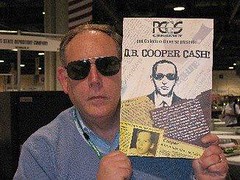
Dan Demeo writes: "Thunderbird doesn't like any messages with images, have to click a button to see them, I can do that. The new message is 50%+ larger, 113kB vs. 69kB, couple of megabytes over the course of a year, not really of any consequence to those of us who archive our own copies of the E-Sylum.
"All in all, I guess the sexy new format outweighs the disadvantages. Who am I to stand in the way of progress?"
To view the issue on the web, you could subscribe to The E-Sylum RSS feed. We've offered this format for a while, and several subscribers use it. It will be more prominent when we complete the upgrade of the NBS web site. The address for our XML feed is http://www.coinbooks.org/feed.xml
Granvyl Hulse writes: "At present I am working with Windows 98 and two tin cans and a piece of string for a link so your new version of The E-Sylum does not come through as it should. I'll have to stick with the older set up until the IRS sends me my rebate and I can get a new computer. Hopefully I will be in the 21st century later this summer."
Saul Teichman writes: "I prefer the original format. Lotus Notes email, at least with the settings I have really wraps the text tightly so that it wastes much of the screens available space. It is easier to read in the old format."
MORE ON NBS' GREATEST AMERICAN NUMISMATIC LITERATURE SURVEY
Len Augsburger writes: "After we published the candidate list in The Asylum, a lot of people wrote in with suggestions, nearly all of which we were able to accommodate. No problem with write-ins or combining entries, do the best you can and we'll do the same on this side."
As to how to think of this exercise, David Gladfelter writes: "Assume you are a historical society curator or librarian who is being downsized. The trustees are making you sell off most of the numismatic library to raise money so they can install computers and be relevant to the modern generation. What you save, you have to rank in importance, 1 to 100, so the next wave of downsizing won't wipe out the heart of the collection. You must keep what your standards of curatorship/librarianship require you to keep, not your pet favorites."
Fred Reed writes: "I got my ballot for the NBS “2008 Survey of the 100 Greatest Works of U.S. Numismatic Literature” this week, and spent several enjoyable hours weighing the alternatives. I’ve run beauty contests like this before, and I congratulate those involved in preparing the listing which was a lot of work, and especially those with the chore of tabulating ballots, which will no doubt be onerous, too. What these kinds of contests do generally is generate a great deal of debate, so let the discussion begin ...
"While I am delighted to see my “Civil War Encased Stamps: the Issuers and their Times” on the list, I am amazed at how much the works selected appear to reveal the collecting biases of the compilers. For example, very few paper money works are included, and several of the paper money works that are listed are VERY suspect. The Society of Paper Money Collectors awarding winning journal “Paper Money,” which is in its 47th year of publication is not listed either.
"I agree with Alan Weinberg about the Sullivan-DeWitt book. I’ve filled out my ballot, and although nothing was said of write-ins, my ballot contains 24 worthy volumes that weren’t on the official ballot. We’ll see how they tabulate. Here they are:
- Fricke, Collecting Confederate Paper Money
- Paper Money (SPMC journal), 1961-date
- Smythe, Schingoethe Sales, 14 parts
- Krause and Mishler, Standard Catalog of World Coins
- Bank Note Reporter (Criswell, Sheheen, Krause)
- Hessler, The Engravers Line
- Pick and Krause, Standard Catalog of World Paper Money
- Hessler, The International Engravers Line
- Criswell, Confederate and Southern States Currency
- Kelly, National Bank Notes
- Schwan and Boling, World War II Remembered
- Huntoon, US Large Size National Bank Notes
- Mihm, A National of Counterfeiters
- Kolbe, Ford Sale, 2 parts
- Smith, American Numismatic Biographies
- Swiatek and Breen, Encyclopedia of US Silver and Gold Commemorative Coins
- Friedberg, Encyclopedia of US Fractional and Postal Currency
- Hessler, U.S. Essay, Proof and Specimen Notes
- Doty, McMillan Encyclopedic Dictionary of Numismatics
- Ball, Financial Failure and Confederate Defeat
- Hessler and Chambliss, Comprehensive Catalog of U.S. Paper Money
- Knox, United States Notes
- Schwan, Military Payment Certificates
- Reed, Standard Catalog of Motion Picture, Television, Stage and Advertising Prop Money
Len Augsburger adds: "I've received 24 ballots so far. In case any readers were wondering, the ballots can be folded and returned in the enclosed envelope for regular (42 cents) postage. Let's keep them coming!"
To read the previous E-Sylum article, see: BALLOTS MAILED FOR GREATEST AMERICAN NUMISMATIC LITERATURE SURVEY
FANNING NUMISMATIC LITERATURE FALL 2008 AUCTION SALE ANNOUNCED
- A charming copy of Patin’s 1683 Introductio ad historiam numismatum
- Godonnesche on the medals of Louis XV (1736)
- Erasmus Froelich’s 1737 Quatuor tentamina
- Mechel on Hedlinger’s medals (1776-1778)
- 18th-century American almanacs, newspapers and mercantile publications discussing coinage
- The 1798 first American edition of Kyd on bills of exchange
- Simon (1810) and Lindsey (1839) on Irish coins
- Important European catalogues including the Jeronimo Vries catalogues of the 1847 Van Gelder sale
- a bound volume of very early J. Schulman sales
- Hess’s 1891-1892 Reimmann sale
- several Ars Classica sales
- Several 19th-century U.S. works on counterfeit detection
- Winslow Howard’s heavily annotated copy of the 1855 Kline sale
- A large paper copy of Hickcox on the paper money of New York
- Copy number 1 of Hough on Washingtonia, published by Woodward
- An original Crosby in a Nova Constellatio binding
- A fine leather-bound set of Loubat
- A number of 19th-century American auction sales with photographic plates, including a plated copy of the 1886 Maris sale
- The second edition of De Knight on U.S. currency
- A plated copy of Elder’s 1908 Gschwend sale
- A plated copy of the Malcolm N. Jackson sale (US Coin Co., 1913)
For more information, please contact David Fanning at dfanning@columbus.rr.com or see the company’s Web site at www.fanningbooks.com.
NEW BOOK: ALEXANDER AND THE HELLENISTIC KINGDOMS: THE WESTMORELAND COLLECTION
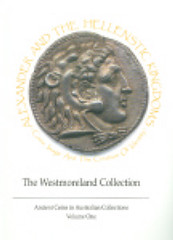 Ian Stevens of The David Brown Book Company
writes: "We have just become the distributor for a book published by the
Australian Centre for Ancient Numismatic Studies, who are based at
Macquarie University.
Ian Stevens of The David Brown Book Company
writes: "We have just become the distributor for a book published by the
Australian Centre for Ancient Numismatic Studies, who are based at
Macquarie University."The book, which appeared at the end of 2007, has just arrived in stock. Esylum readers may be interested to know about it."
This lavishly-produced catalogue presents one of the finest collections of Hellenistic coins in Australia. The enlarged pictures are designed to allow close inspection of detail, for the serious collector, but is also suitable for those who have a more general interest in all things 'Alexander'. 172p, col photos of all 87 coins (Ancient Coins in Australian Collections 1, Australian Centre for Ancient Numismatic Studies 2007)
BOOK REVIEW: PRE-DECIMAL COINS AND TOKENS FROM THE ISLAND OF JERSEY
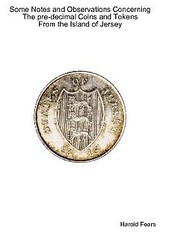 I had the pleasure of reviewing a new book,
Some Notes and Observations Concerning The pre-decimal Coins and Tokens
from the Island of Jersey, by Harold Fears (copyright 2008). This book
is the work and study of many years on the coins and tokens of the Island
of Jersey issued from 1812-1966. The book will become the standard
reference for coin collectors of Island of Jersey pre-decimal coins and
tokens.
I had the pleasure of reviewing a new book,
Some Notes and Observations Concerning The pre-decimal Coins and Tokens
from the Island of Jersey, by Harold Fears (copyright 2008). This book
is the work and study of many years on the coins and tokens of the Island
of Jersey issued from 1812-1966. The book will become the standard
reference for coin collectors of Island of Jersey pre-decimal coins and
tokens. The Island of Jersey is one of the Channel Islands, located off the coast of France between France and England. The Island of Jersey belongs to the British Crown. Being close to France, the money used on the island has been influenced by both French and British coinage.
Mr. Fears is an expert on Jersey coinage, and has prepared a detailed book of his research. The 321 page color book has excellent pictures, and there are pictures on most pages. The pictures are of high quality. He used 1200 psi for the scanned coins, and 2400 psi of photographs for die identification.
Coins in the book are cross-referenced with “KM “numbers (from Krause-Mishler’s Standard Catalog of World Coins) numbers and “J” numbers (from McMammon’s Currencies of the Anglo Norman Isles). There is also an extensive bibliography.
The first part of the book covers the tokens and coins issued for the Island of Jersey beginning in 1812. Tokens were issued in 1812, 1813 and 1814. Pre-decimal coins were first issued in 1841, and ended in 1966. Coins were not issued every year, but as needed for commerce on the island. The pictures of the coins are enlarged so that it is easy to see the beautiful details.
The second part of the book covers die varieties of the coins. This section is for a specialist who wants to identify the many different die varieties. Mr. Fears calls this section “Rapid Die Identifier” and provides detailed, enlarged photographs of the different die varieties and die pairings that make identification of a coin easy.
Throughout the book, there are stories of interesting facts and history of the island, coinage, Jersey banknotes, and British monarchs. It is interesting to read about why the coins were issued in a particular year, and the needs of the people on the island.
How to order book: Available only on www.Lulu.com Lulu ID number is: 2124163 Cost: $69.99 for paperback, coil binding, full-color interior, 321 pages
NEW BOOK: WALKING LIBERTY HALF DOLLARS BY JEFF AMBIO
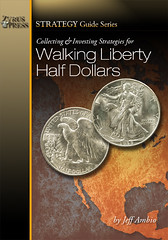 The second book of the “Strategy Guide Series,”
Collecting and Investing Strategies for Walking Liberty Half Dollars is
the perfect tool for the collector or investor of Walking Liberty Half
Dollars.
The second book of the “Strategy Guide Series,”
Collecting and Investing Strategies for Walking Liberty Half Dollars is
the perfect tool for the collector or investor of Walking Liberty Half
Dollars. As the only book available on the subject today, Ambio completely reevaluates the Walking Liberty Half Dollar series in light of profound changes in the market during the past 20 years.
Following a classic date-by-date analyses of each Business Strike from 1916-1947 and Proof Issues from 1936-1942, this book provides vital information on strike, luster, rarity analysis, pricing data, prices realized and significant examples.
Each section concludes with Ambio’s trademark “Collecting and Investing Strategies,” which provides invaluable tips and insights into how and what to buy.
Order this book before June 1st and receive FREE SHIPPING! Order online at www.zyruspress.com, Amazon.com or call us at 888-622-7823 to reserve your copy today!
- Published by Zyrus Press, Inc. of Irvine, California (www.zyruspress.com)
- Publication Date: 5/15/2008
- Binding / Size: Paperback / 7” x 10”
- Pages: 200
- Photos / Illustrations: 150+ b+w images
- ISBN-10: 1-933990-17-1
- ISBN-13: 978-1-933990-17-0
- Suggested Retail Price: $29.95
- Contact: PO Box 17810, Irvine, California 92623.
- Phone: (888) 622-7823.
- E-mail: info@zyruspress.com.
- Fox, Bruce, The Complete Guide to Walking Liberty Half Dollars, 1993
- Swiatek, Anthony, The Walking Liberty Half Dollar, 1983
CURATORIAL TOURS OF PRINCETON'S RENAISSANCE NUMISMATICS EXHIBIT
 Alan Stahl, Curator of Numismatics at Princeton
University, will give the final two curatorial tours of the exhibit
“Numismatics in the Renaissance” at the Firestone Library on Friday, May
30 at 2 p.m. and Sunday, June 1 at 3 p.m. The exhibit will remain on view
in Firestone’s Main Exhibit Hall through July 20.
Alan Stahl, Curator of Numismatics at Princeton
University, will give the final two curatorial tours of the exhibit
“Numismatics in the Renaissance” at the Firestone Library on Friday, May
30 at 2 p.m. and Sunday, June 1 at 3 p.m. The exhibit will remain on view
in Firestone’s Main Exhibit Hall through July 20.The exhibition includes rare fifteenth- and sixteenth-century volumes from Princeton’s Rare Books Division that discuss and illustrate ancient coins, and a display of some of the treasures of the Library's Numismatic Collection, featuring gold, silver, and bronze coins of Greece and Rome, as well as coins and medals of the Renaissance that were inspired by them. The exhibition also includes manuscripts, prints, and drawings from Princeton University collections and Pirro Ligorio's monumental map of ancient Rome, made in 1561.
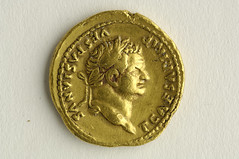 Although ancient coins were found throughout the
Mediterranean region in the millennium following the end of the Roman
Empire, it was only in Renaissance Europe that they began to be studied
systematically; reproductions appear in some of the earliest printed books
to carry engraved illustrations. The Princeton collection is particularly
rich in these impressive examples of early printing, ranging from the 1517
edition of Andrea Fulvio's Images of the Illustrious, with its highly
decorated settings of each coin image, through Hubert Goltzius's
large-scale chiaroscuro reproductions of imperial portraits of the 1550s,
to Antonio Augustín's late sixteenth-century systematic classification of
ancient coinage and guidelines for detecting counterfeits.
Although ancient coins were found throughout the
Mediterranean region in the millennium following the end of the Roman
Empire, it was only in Renaissance Europe that they began to be studied
systematically; reproductions appear in some of the earliest printed books
to carry engraved illustrations. The Princeton collection is particularly
rich in these impressive examples of early printing, ranging from the 1517
edition of Andrea Fulvio's Images of the Illustrious, with its highly
decorated settings of each coin image, through Hubert Goltzius's
large-scale chiaroscuro reproductions of imperial portraits of the 1550s,
to Antonio Augustín's late sixteenth-century systematic classification of
ancient coinage and guidelines for detecting counterfeits.The role that the study of ancient coins played in Renaissance culture is illustrated through the display of art works of the period that depict objects of classical antiquity, most notably a drawing by Parmigianino in the collection of the Princeton University Art Museum with an image of the goddess Minerva apparently derived from one on Roman coins. Selected Renaissance coins and medals will highlight the efforts of rulers of the period to present themselves in the guise of ancient leaders. Coin imagery in Renaissance literature will be shown by the pairing of Tudor coins with early editions of Shakespeare's history plays, which are particularly rich in puns on coin names and details.
"Numismatics in the Renaissance" is free and open to the public. Gallery hours are weekdays from 9 a.m. to 5 p.m., plus Wednesday evenings until 7:45 p.m., and Saturdays and Sundays from noon to 5 p.m.
ANA SEEKING BALTIMORE NUMISMATIC THEATRE PRESENTATIONS
Numismatic Theatre consists of presentations on a wide variety of topics. It's a wonderful opportunity for collectors to communicate their ideas and research with the numismatic community. The talks are an educational highlight of every ANA convention, and often focus on a wide range of topics including themes pertaining to a convention's host city.
Presentations from previous ANA conventions range from "Famous Numismatists of the Past and Present: Focus on Baltimore" and "The Panic & Depression of 1837-41: Baltimore's Shinplaster Bank," to "A Numismatic Look at Colonial Annapolis" and "The Medallic Art of Baltimore Sculptors Hans Schuler & Hans C. Schuler."
ANA members interested in giving a Numismatic Theatre presentation can download a proposal form at www.money.org (select "World's Fair of Money" from the "Numismatic Events" scroll down menu, then select the "Education" tab and click on "Numismatic Theatre"). Applicants can either mail proposals to American Numismatic Association, 818 N. Cascade Ave., Colorado Springs, CO 80903 or fax them to 719-634-4085. Proposals must be received by June 20.
THE BOOK BAZARRE
48% OFF FOR 48 HOURS ON 2009 REDBOOKS! Wizard Coin Supply offers Spiral $7.77, Hardcover $8.81, Hidden Spiral $10.37 Hurry - sale only lasts 48 hours www.WizardCoinSupply.com
COIN CHAT RADIO PROGRAMMING MAY 15-21
Auction news in "Going Once" with Bank Note Reporter Editor Dave Kranz; news of recent world coin issues in "Freshly Minted" with Online Editor Lisa Bellavin; a look at Josh Tatum and the Racketeer nickel in "Talking Type and Beyond" with Bob Van Ryzin; and an "On the Club Scene" interview by Numismatic News Editor Dave Harper with Florida United Numismatists Convention Coordinator Cindy Wibker about the upcoming Summer FUN Convention.
Past shows can also be accessed in the Archives on the Web site. Coin Chat Radio is brought to you by Krause Publications.
JUST WHAT ARE THOSE OBVERSE MARKS ON SOME 1794 DOLLARS?
Concerning the 1794 dollar addressed in last week's E-Sylum, Alan V. Weinberg writes: "I recently considered for acquisition and closely examined the Eliasberg 1794 dollar in PCGS slabbed EF-45. I noticed a number of obverse "pin pricks" - somewhat shallow, slightly angled Stylus point- like pricks in the silver metal. I recall them only on the obverse. I wondered about these. I discussed the phenomenon with noted early dollar expert Dave Perkins and he had no explanation but vaguely recalled seeing such marks on a few other early dollars."Comes the Goldberg pre-Long Beach May 25-27 auction catalogue and I note lot 4000- a decent-appearing 1794 dollar NCS graded Details of VF 20 . By golly! The exact same obverse -only surface pin pricks, identical in depth and nature to the Eliasberg coin's but this time more numerous. The Goldberg catalogue's only reference to these surface pricks is "small obverse marks". I'd surmise that the slightly greater number of these marks on this dollar resulted in NCS grading this coin whereas the Eliasberg dollar made it into a PCGS holder.
"I wonder about these identical sharp pointed, slightly angled "jabs" in the metal surface on only 1794 dollars. Can anyone enlighten the hobby? My best guess is early on in the US Mint the 1794 dollars were struck and then shunted aside by some counting/sorting device with sharp points like a large fork. And that the Mint quickly substituted the device when the surface damage was noted. Or a similar device at an early central counting bank which, when noting the damage done to the country's then greatest coin, quickly abandoned the device.
"To the best of my knowledge, these marks do not appear on dollars later than 1794 nor on early halves. Why?
"One other hypothesis occurred to me relating to the sharp surface punctures on the Eliasberg and Goldberg dollars: that this was done by some ignorant fool in the 1790's with a knife and too much time on his hands. But this can be discounted - what are the odds of two such 1794 dollars still existing? And, more importantly, if these surface jabs were done by a vandal with a knife point, why isn't there any evidence on either dollar of a slip with the knife and some deep accidental gouges or scratches? No, this surface damage was done mechanically, and only on 1794 dollars."
JUDGE RULES ANS MUST RETURN COLLECTION TO HISPANIC SOCIETY
Judgment is hereby entered for Plaintiffs, The Hispanic Society of America and The Board of Trustees of The Hispanic Society of America, against Defendant, The American Numismatic Society, Inc.
Defendant shall accord Sotheby’s, Inc. (“Sotheby’s”) and such experts, specialists and technicians as Sotheby’s may designate in writing to both Defendant and Plaintiffs the unimpeded right to inspect, identify, verify, separate and value the coins comprising the Coin Collection (the “Tasks”) at the premises of Defendant at 96 Fulton Street, New York, New York
STACK'S TO AUCTION S.S. NEW YORK SHIPWRECK GOLD FIND
Last year, four Louisiana residents salvaged hundreds of gold coins and thousands of silver coins from the wreckage of the SS New York in about 60 feet of water in the Gulf of Mexico, said David Bowers, co-chairman of Stack's Rare Coins in New York.
"Some of these are in uncirculated or mint condition," Bowers said, predicting the best could bring $50,000 to $100,000 each at auction.
Those coins were struck at mints in New Orleans; Charlotte, N.C.; and Dahlonega, Ga. The Charlotte and Dahlonega mints operated from 1838, when the first significant U.S. gold deposits were found in those areas, until the start of the Civil War in 1861, said Douglas Mudd, curator of the American Numismatic Association's Money Museum in Denver. Neither mint ever reopened.
The New York was a 165-foot sidewheel steamer built in its namesake city in 1837. By 1846, it was making regular commercial runs between Galveston, Texas and New Orleans. A storm took the ship to the bottom, killing 17 of the 53 people aboard. The other 36 were rescued.
A group of four hobbyists, who enjoyed looking for sunken vessels in the Gulf, discovered what was left of the SS New York around 1990. After several trips in the ensuing years and bringing up a handful of coins at a time from the mud that virtually covered the ship, the four invested in a full-scale salvage operation in 2007.
John Albanese, a rare coin dealer in Far Hills, N.J. since 1978, appraised about 200 of the gold coins. "This is the most impressive Southern-minted gold I've seen in my lifetime," he said.
To read the complete article, see: Coin dealers examining gold find from Louisiana coast
QUERY: KERENS, TEXAS GOLD HOARD
Web site visitor Chisum Whorton of Texas writes: "I came across your article regarding the gold found at the A.L. Bain ranch on www.coinbooks.org. A.L. Bain was my great grandfather. I have heard many stories regarding this through my grand mother over the years. I had thought they had said much of the gold was taken when it was found, but several pieces were kept. It has been many years but I remember seeing some of these as a child. Any information you could send would be of great interest.MORE ON AUTHOR THOMAS MOLL
R. J. Hammond of Bethlehem, PA writes: "I wish to thank you (and David Lange) for the tidbit about Lulu.com, Thomas Moll, and his other publications. Of interest to me is Thomas Moll's book concerning Coin Holders/Folders from the 1950's through the 1960's. Of greater interest to me though, is his array of Pennsylvania German genealogical booklets, of which I purchased his first offering in 2001."As an aside, I went to his house, which is near me, to purchase it. Since then, he has either moved or become reclusive (he never answers the door). I could acquire his other publications, since contact was been interrupted.
"Back to Lulu.com. I've now ordered his other Pennsylvania German booklets to add to my growing library (over 5000 books, pamphlets, and other ephemera). So...Thanks!"
To read the previous E-Sylum article, see: BOOK REVIEW: GUIDE TO VINTAGE COIN FOLDERS AND ALBUMS BY THOMAS MOLL
LONDON MAYOR SCRAPS PRINT NEWSPAPER, PLANTS TREES
Up to £1m of the saving will be used to fund the planting of 10,000 new trees in London's most deprived areas, says Mr Johnson. The mayor aims to have all the new trees planted by the start of the 2012 Olympic Games.
To read the complete article, see: Mayor scraps paper for trees plan
NUMISMATOURIST HOWARD BERLIN PLANS TRIPS
Howard Berlin writes: "I will be in Chicago to see Number 1 son and a few coin museums after the ANA convention and a few days later I'll be off to Edinburgh, Glasgow, and Londinium. I plan to see the coin collection at the National Museum of Scotland in Edinburgh and the Hunterian Gallery collection in Glasgow.I will also be off to Manchester, Liverpool and London again in November. Next year's trips currently include Berlin (again), and Israel (again) with possibilities to visit numismatic museums in Doha, Qatar and Vienna, especially if the euro drops. Havana is also a definite maybe either for '09 or '10."
MORE ON THE HONOR SYSTEM OF PAYMENT
John Regitko of Canada writes: "The article about an Ontario bakery honor system reminds me of the time two of my school chums and I drove through the Province of Quebec on vacation and were faced with the honor system when we decided not to eat at the restaurant all the time but purchase cold cuts and a loaf of bread."In one instance, as we were driving along the road, we noticed a sign (in French and English) stating that bread was for sale up the driveway. We drove in and noticed that the covered loafs were lying on a table outside with a note asking us to drop $1 in a wooden box that had a slot on top. I wondered how many times someone had the temptation not just to “forget” to pay, but actually walking off with the whole box of money that couldn’t have weighed more than a couple of pounds.
"The other instance, we were again directed to the farm house on a country road, but this time there was a sign on the entrance to the house stating that the bread was inside. We walked in, shouted “hello” to attract someone’s attention. We saw loafs of bread on the table, along with a small cardboard box which contained $7. When nobody came, we took two loafs of bread, paid $2 and left, wondering if the next person would be tempted to take the $9 cash.
"Since this appeared to be a common occurrence, I can only assume that there are a lot of honest people out there!"
To read the previous E-Sylum article, see: ONTARIO BAKERY SUCCEEDS WITH HONOR PAYMENT SYSTEM
WAYNE'S NUMISMATIC DIARY: MAY 13, 2008
On Tuesday evening I went to the monthly meeting on my Northern Virginia numismatic social club, Nummis Nova. Our host was Chris Neuzil who made a reservation at the Jasmine Cafe restaurant in Lake Anne Plaza in Reston. My son Tyler's Little League baseball game had been cancelled due to field conditions, so I was able to arrive on time around 6:30.The first member I saw was Roger Burdette, who was waiting near the fountain. We discussed the architecture of the plaza, which was built as a showcase planned community. In his RSVP for the meeting Tom Kays, a "NoVa native" wrote: "I remember when they built Reston and even visited once back in 1968 to look around. I remember a lake. Do you suppose much has changed since then? Will I recognize the place and appreciate the genius of planned communityhood?"
Well, the community's still there but to Roger and I it didn't look like a work of genius. It looked dated (early 70s was my guess) and felt sluggish. The plaza was as nearly still as the water on the "lake", which was more of a big concrete reflecting pond. Later that evening one of the group said it looked like communist East Berlin.
There was activity though, probably not bad for a Tuesday night. Shops and restaurants were open, some with outdoor seating and at least one with live music. No big crowds, though. One of the lessons learned from these planned communities is that if the shopping areas are hidden from the road as this one was, you can't count on people beating a path to the door. I've been in this area for two years and never knew it was there. But the isolation worked to our advantage - plenty of seats and little noise in the restaurant (The Jasmine Café).
While we were talking I spotted Julian Leidman rounding the corner across the plaza, with his trademark magnifiers still clipped to his glasses. We walked over to the restaurant and Chris and the rest of the gang were already there. Tom Kays was sick and had to cancel, so he'll have to take our word that the lake is still there.
Rounding out the group were Joe Levine, Dave Schenkman, Wayne Herndon and Traci Poole. Traci was Wayne's guest - a former ANACS employee, Traci now lives in Virginia and works for Wayne in his coin business.
Chris' theme for the evening was "Your best or most memorable (not necessarily most remunerative) numismatic 'find.' From circulation, cherrypicked, metal detector, or however." He passed out copies of his article How Lucky Can You Get? from the October 2002 Numismatist. He and fellow collector Lenny Vaccaro purchased two rare and valuable silver U.S. Mint medals commemorating heroes of the War of 1812 on eBay for a fraction of their typical selling price.
Dave Schenkman recalled a deal where a gentleman who'd changed his collecting focus practically insisted on trading high-grade U.S. Colonial coins to Dave in exchange for saloon tokens.
Julian Leidman told the tale of a collector in Mexico who contacted him with a group of British coins to sell. One piece seemed special and the man shipped it to Julian, who took it to a Long Beach show and sold it on the man's behalf for $200,000 - it was a bronze denarium of Maryland.
Roger Burdette remembered his adventure as a young collector when a bank in his area was offering to sell five silver dollars for face value as a promotion, one set to a customer. One of his five was an 1893-S, worth $3,000 today. Dave added that in the 1950s (before the Treasury hoard was released) he bought a 1903-O Morgan dollar through a banker who lived across the street from him.
I told about the time when my wife asked what I'd done that day and I said I'd made $2,000 in the bathroom. I was passing time reading Coin World and noticed a rare U.S. encased postage stamp worth over $2,000 at the time being offered for $250. I raced to the phone and called the dealer who insisted on letting me have it for $225 "because in was in last week's ad at that price and it didn't sell." The piece arrived in fine shape and was sold in 2006 along with the rest of my EPS collection for about $7,000.
Joe Levine recalled his days as a student when he'd get bags of nickels or half dollars from the Treasury and sort through them for better coins to sell, making $20 or more a week - good money in those days. When the Treasury began its silver dollar release in 1962-63, Joe worked as a go-fer for Phil Lampkin of the Washington Coin Exchange helping to haul bags of silver dollars (going up and down flights of stairs to Phil's office, where the bags were opened and examined). Lampkin would buy 10-15 bags at a time, often making $300 on each. Dealer Ben Douglas was the talk of the hobby after finding he'd bought a bag of Liberty Seated dollars for face value.
Joe raised $12,000 from relatives, hired an off-duty cop for security and borrowed a car to buy bags of his own. He found a bag of 1882-Os, and Phil sold them for him. Phil scored a bag of 1883-CCs. Joe remembers the coins stacked in piles of twenty on Phil's desk. After making calls to Harry Forman and several other dealers across the country, Phil sold them all without affecting the price.
Joe remembered how one dealer from Georgia arrived at the Treasury with a long tractor-trailer and loaded it up with 200-300 bags of dollars, only to discover too late that another dealer had already checked and returned the bags, marking them with a small "x".
One of Traci Poole's better finds happened just that afternoon, when her order of ten silver 2008 eagles arrived from the U.S. Mint - all ten had the reverse of 2007.
Wayne Herndon passed around two interesting pieces he picked up at shows recently - an unrecorded original "Bo" Hobo nickel, and a Morgan dollar whose obverse was recarved into an image of Buffalo Bill Cody. Other topics covered in conversation included activities at ANS, Heritage and Stack's. New books held the spotlight for a few minutes: Julian Leidman mentioned George Fuld's revised manuscript on Washington items, and Joe Levine discussed Bill Swoger's book on National Commemorative medals.
It was another pleasant evening of numismatic discussion - great companionship, and great stories. I was already looking forward to next month. I got back to my parked car and managed to wind my way through the maze back to the main road, leaving the secret shopping plaza behind.
LEGISLATION WOULD REQUIRE PALLADIUM COIN
The state has the nation's only palladium mine. Stillwater Mining Co. operates it near Nye, north of Yellowstone National Park.
Two bills, one in the U.S. House and one in the Senate, would require the Mint to reproduce a $20 coin released in 1907 as a gold piece. Palladium is used in catalytic converters installed in automobiles to reduce emissions.
Legislation requiring a palladium version passed the House unanimously on Thursday. In the Senate, a similar bill is pending before the Banking, Housing and Urban Affairs Committee.
"This coin is another great way to put Montana on the map,'' said Sen. Max Baucus, who sponsored the Senate bill along with Sen. Jon Tester, his fellow Montana Democrat. "Palladium is unique to the Big Sky state. Producing this coin will help create good-paying jobs and help boost the state's economy.''
"The resulting increase in (palladium) demand will provide a boost for Montana's mining families and the local community, and that's a great move,'' Rehberg said.
To read the complete article, see: Legislation would require palladium coin
BYZANTINE GOLD COINS OF EMPEROR VALENS UNEARTHED IN EGYPT
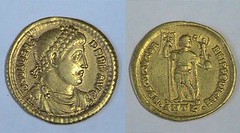
Zahi Hawass, secretary-general of the SCA, described this discovery as unique because it is the first time that objects linked to that emperor have been found in Egypt. "Coins of Valens were previously found in Lebanon and Syria," Hawass said, adding that remnants of walls along with fragments of clay, glass and porcelain dating to the same era were also unearthed.
On the obverse side is an image of Emperor Valens wearing his official attire and an ornate crown decorated with two rows of pearls surrounding a gold cross. The reverse shows the emperor in military attire, holding in his left hand a staff with a cross and in his right a ball surmounted by a winged angel.
To read the complete article, see: Heads or tails? in the Al-Ahram Weekly.
TEAM CREATES CANADIAN VICTORIA CROSS MEDAL
The Canadian Victoria Cross is made using the same methods, awarded for the same reasons, and even uses some of the same metal that went into the British original, dating back to 1856, during the reign of its creator, Queen Victoria.
The design is virtually identical but for the addition of fleurs-de-lis and a change from the English inscription "For Valour" to the Latin "Pro Valore."
After more than 15 years in the making -- from design consultations to its final ribbon-mounting -- the medal was unveiled to the public yesterday. In the audience was metallurgist Peter Newcombe, who grew up in Flamborough and manages the research foundry at the federal CANMET materials laboratory in Ottawa -- a lab that usually develops materials and techniques for use in industry.
Newcombe was one of the core group of four, and part of a broader team of 19, who created the alloy and physically produced the medal itself, using a traditional technique called lost-wax, or investment casting, in which liquid ceramic material is poured around a wax model. After it hardens, the wax is melted, leaving a ceramic mould.
The entire process, including the recipe for the alloy that makes up the Victoria Cross, is shrouded in secrecy, meant to protect the integrity of the rare and oft-copied medal.
Original Victoria Crosses were made using metal from the cascabels of two cannon (the cascabel is the knob at the rear) captured from the Russians in the Crimean War.
The British contributed a slice of their diminishing and closely guarded supply to be incorporated into the Canadian alloy. In addition, an 1867 Confederation medal was melted into the mix. The other ingredients in the alloy are Canadian metals, primarily copper, gathered from every corner of the country.
The team made 20 Victoria Crosses in all, documenting the process in case it ever needs to be repeated. The medals and ingots of the special alloy are stored in a vault at Rideau Hall.
To read the complete article, see: Skill, history, secrecy forge military medal
COUNTERFEITERS STOCK UP ON HAIRSPRAY
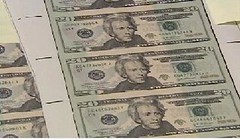
The ring is responsible for printing and distributing nearly $7 million in bogus currency over the last two years, authorities said.
Assistant U.S. Atty. Tracy L. Wilkison, the prosecutor on the case, said it was unusual not just because of the amount of money, but because agents were able to go up the food chain in their investigation.
"Most of the time what we have is a handful of poorly crafted bills in small amounts," she said. "When we're able to trace it all the way back to the source and stop the printing, that's a big coup."
The bills, allegedly produced with computers and ink jet printers, were of particular concern to agents because they had proved difficult to detect and were passed in locations across the United States.
A search of Talton's home turned up "a full-scale counterfeit currency manufacturing plant" and more than $1 million in completed and partially completed fake bills, according to an affidavit filed in U.S. District Court in Los Angeles. Among the evidence found in the baldheaded suspect's trash were 20 bottles of Aqua Net and White Rain hair spray.
Authorities say the hair product is commonly used to coat fake bills to block the counterfeit-detecting pens used by merchants.
As he was being taken into custody, Talton admitted that he had printed between $5 million and $6 million in fake currency, authorities said.
To read the complete article, see: Five arrested after Secret Service probe into Southern California counterfeit ring
BRAIN TEASER ANSWER: WHAT DO THESE WORDS HAVE IN COMMON?
- Banana
- Dresser
- Grammar
- Potato
- Revive
- Uneven
- Assess
Jim Davis picked up on the "mass of doubled letters", as did Joseph D. McCarthy who writes: "The obvious answer is that each word contains TWO sets of letters that are each used TWICE."
Bob Laetare writes: "Your word puzzle was easy, or else I am completely wrong. All of the words have two sets of double letters."
True, but there's more to it than that. Carl Honore was very close - his answer was the same as mine. He writes: "Each word begins with a letter followed by a palindromatic figure; the rest of the word can be read forwards or backwards."
Martin Purdy and Pete Smith were close as well. Martin writes: "Take away the first letter and you have a palindrome in each case." Pete adds: "There is a connection with numismatics - some banknotes have palindromic serial numbers. These are also called "radar" notes for obvious reasons. As Christopher figured out, all the words in your brain teaser are pallandromes with an added letter in front."
Joe Boling nailed it with a very succinct explanation, which was how my son Christopher answered it. Carl, Martin and Pete's answers are arguably identical to this one, but Joe's response is closest to how the author of the quiz described the answer. Joe writes: "Move the first letter to the back and read it right to left - same word."
Rich Mantia writes: "I got it now. That's really intense! That's why Dave is at the top of the writer's pool. I was only looking at words that acted as RADAR's in relation to currency. Reversing the word by moving the first letter is truly a MENSA question. Congrats to Mr. Bowers for beating me at a game of 'Stump the Chump'. I really enjoyed it."
Nick Graver's wife Marilyn solved it as well. Many thanks to everyone who participated.
the cascabels of two cannon BRAIN TEASER: WHAT DO THESE WORDS HAVE IN COMMON?
WHAT IF I THREW A PENNY OFF THE EMPIRE STATE BUILDING?
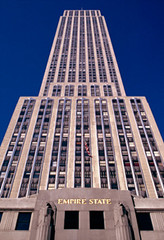 You might have heard the tale about a person
who, standing on the observation deck of the Empire State Building, throws
a penny and makes a wish. In the story, the penny falls and kills a
pedestrian on the sidewalk below.
You might have heard the tale about a person
who, standing on the observation deck of the Empire State Building, throws
a penny and makes a wish. In the story, the penny falls and kills a
pedestrian on the sidewalk below.This is one of those classic urban legends that is untrue but contains a grain of truth.
Throwing a penny off the Empire State Building wouldn't kill someone. A penny only weighs about a gram and it tumbles as it falls. Because of the tumbling and the light weight, there's so much air resistance that the penny never really gathers that much speed before it hits its terminal velocity. A gram of weight traveling at a relatively slow speed might hurt a little if it hit you on the head, but it's not going to kill you.
The grain of truth embedded in this urban legend is the fact that falling objects -- even ones that seem harmless -- can do a lot of damage. That's why people on construction sites wear hard hats. If a big nut or bolt weighing 50 grams (about 1.8 ounces) falls and hits you on the head, it's going to do some serious damage, and depending on the height it falls from, it could definitely kill you if it hit right on top of your skull.
A 1-gram penny falling from the Empire State Building might reach 100 miles per hour. It has a little less than 1 foot-pound of energy when it hits, and just hurts a little.
If a 50-gram nut, or a roll of pennies weighing 50 grams, were to fall from the Empire State Building, it would fall about 1,000 feet. Ignoring air resistance, it would reach a velocity of about 250 miles per hour. That gives it energy of about 100 foot-pounds, which is fatal if it hits you on the head. If you're wearing a hard hat, however, you'll survive.
To read the complete article, see: What if I threw a penny off the Empire State Building?
INTERESTING IMAGES OF DEFACED U.S. PAPER MONEY
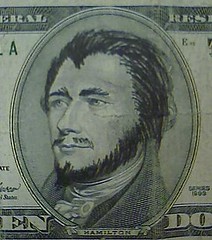 "Flickr's Joe D! has a laugh-out-loud set of 75
"refaced" US bank-notes, in which the various dead presidents are
reinvented as a series of ever-funnier defacements."
"Flickr's Joe D! has a laugh-out-loud set of 75
"refaced" US bank-notes, in which the various dead presidents are
reinvented as a series of ever-funnier defacements.""i'm surprised how much everyone likes this. it's just something i've been toying around with every now and then, it all started when i would draw
 To read the original Boing Boing article,
see: Hilarious
money doodles glasses or beards on money with the counterfeit pen on
the registers at work and just grew in to a hobby. also, keep in mind that
a lot of these were taken with camera phones or in low lighting moments
before i had to spend them (i'm a poor college student, of course i spent
them, i can't afford to keep a collection of twenties
somewhere)."
To read the original Boing Boing article,
see: Hilarious
money doodles glasses or beards on money with the counterfeit pen on
the registers at work and just grew in to a hobby. also, keep in mind that
a lot of these were taken with camera phones or in low lighting moments
before i had to spend them (i'm a poor college student, of course i spent
them, i can't afford to keep a collection of twenties
somewhere)."To view Joe D!'s images, see: Refacing Government Tender
MAN LOSES MONEY TRYING TO DOUBLE IT BY MARINADING
This unidentified man was told by a 32-year-old Frenchman that if he mixed the real cash with blank bills and then marinate them in a special liquid for one night, he would have double the amount of the cash.
The gullible Vietnamese believed the Frenchman's story and gave him 180,000 kroner (35, 000 U.S. dollars). But when he prepared to collect his money the next morning, both the cash and the Frenchman disappeared.
To read the complete article, see: Man loses money trying to double it by marinading
IS NORTH KOREA TO BLAME FOR $100 "SUPERNOTE" COUNTERFEITS?
However, a 10-month McClatchy investigation on three continents has found that the evidence to support Bush's charges against North Korea is uncertain at best and that the claims of the North Korean defectors cited in news accounts are dubious and perhaps bogus. One key law enforcement agency, the Swiss federal criminal police, has publicly questioned whether North Korea is even capable of producing "supernotes," counterfeit $100 bills that are nearly perfect except for some practically invisible additions.
To read the complete article, see: U.S. counterfeiting charges against N. Korea based on shaky evidence
And that's why many experts doubt that North Korea is making the supernotes.
The ink's maker, a Swiss firm named Sicpa, mixes the ink at a secure U.S. government facility. A Sicpa spokeswoman in the United States, Sarah Van Horn, declined to discuss the supernotes. But she offered an important fact.
"We ceased all OVI deliveries (to North Korea) in early 2001, and later in the year all security ink supplies," Van Horn said in an e-mail.
That means that Sicpa cut off North Korea from the high-tech inks well before the sting operations in 2005 that allegedly involved North Korean nationals supplying supernotes and well before the Bush administration publicly began accusing North Korea of making fake $100 bills.
To read the complete article, see: Fake $100 bills have features just like the real ones
FEATURED WEB SITE: CURRENCY INK MAKER SICPA S.A.
This week's featured web site is that of SICPA S.A. the 80-year-old Swiss firm (Société Industrielle et Commerciale de Produits Amon) which produces the specialized inks for intaglio printing used by 80% of countries in the world.http://www.sicpa.com/
